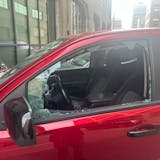Mere hours after the Minnesota State Fair opens, things have already gone missing.
We’re not talking butter-head heists. Or blue-ribbon chicken swiping. Just the everyday things the throngs have with them. Blankies. Hearing aids. Passports.
Outside the lost-and-found office on West Dan Patch Avenue, you can’t go 15 minutes without seeing a stressed-looking someone in search of their missing car keys, or backpack, or something a woman described as “confidential” and declined to discuss.
John Folta rolled out of the office on an electric wheelchair and explained that the fickle weather had bollixed him up. He’d lost his eyeglasses sometime after he’d swapped them for prescription sunglasses. “When I went to change glasses again, because the weather changed, by god, they were gone.”
Folta’s odds of recouping his specs are decent.
Blaire Huneke, the fair’s marketing and guest services supervisor, said roughly 1,800 items were turned in to lost-and-found last year, about half of which were reunited with their owners. (About 1,300 items were reported lost.) Staff have helped fairgoers find their fanny packs and reclaim their retainers. They’ve pressed still-plump wallets into grateful hands.
The most commonly lost items, Huneke said, are sunglasses, water bottles, phones, wallets and IDs. After that, it varies, depending on weather. “If we have a really rainy fair, umbrellas will be the top item,” she said. “And if we have a really cold fair, it might be sweatshirts.”
Sentimental items are among the most lamented, such as a wedding ring or a kid’s prize won at the Midway. The most unusual item people turn in is dentures.


